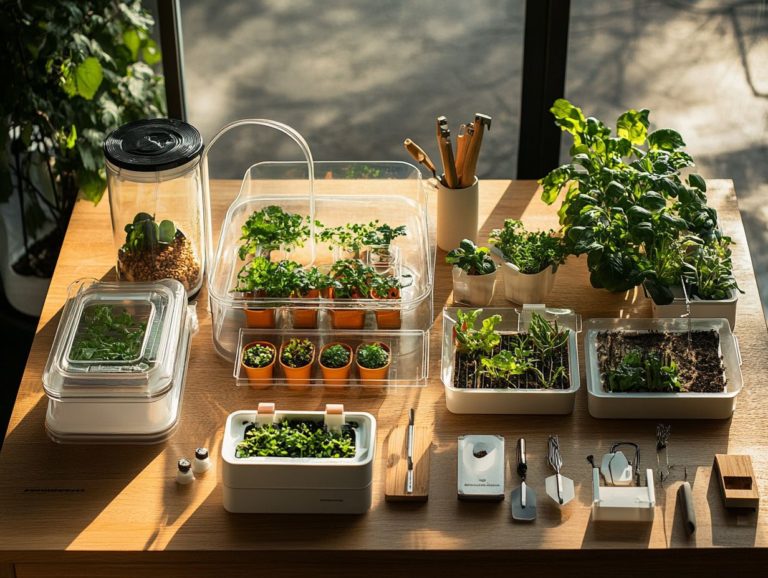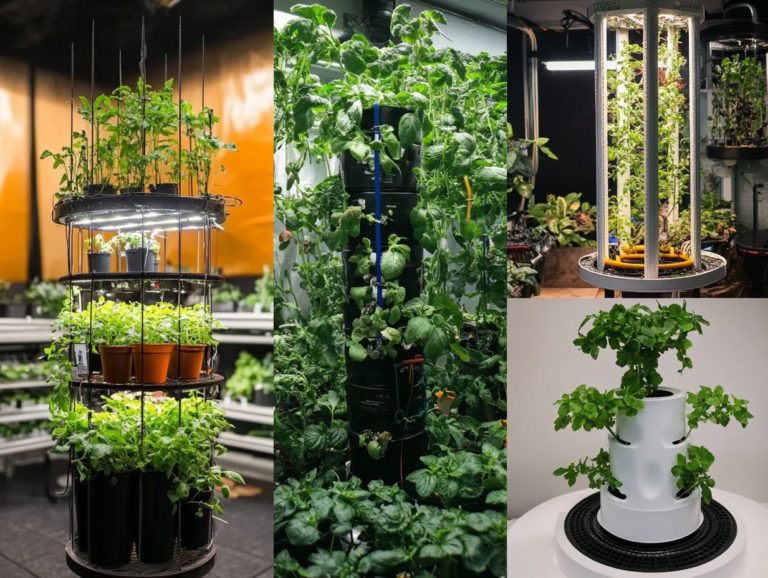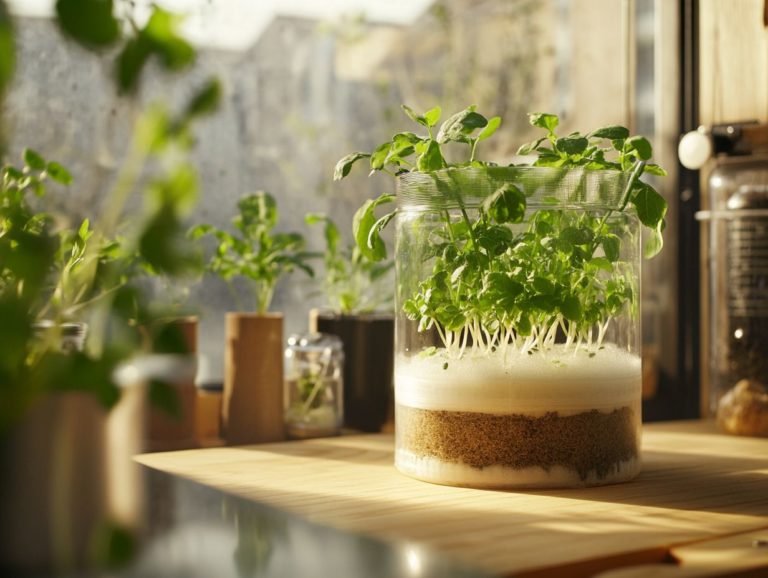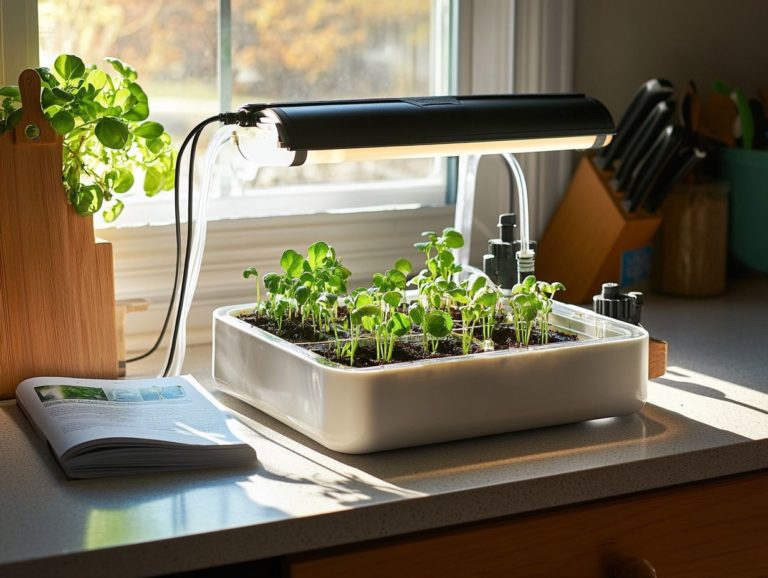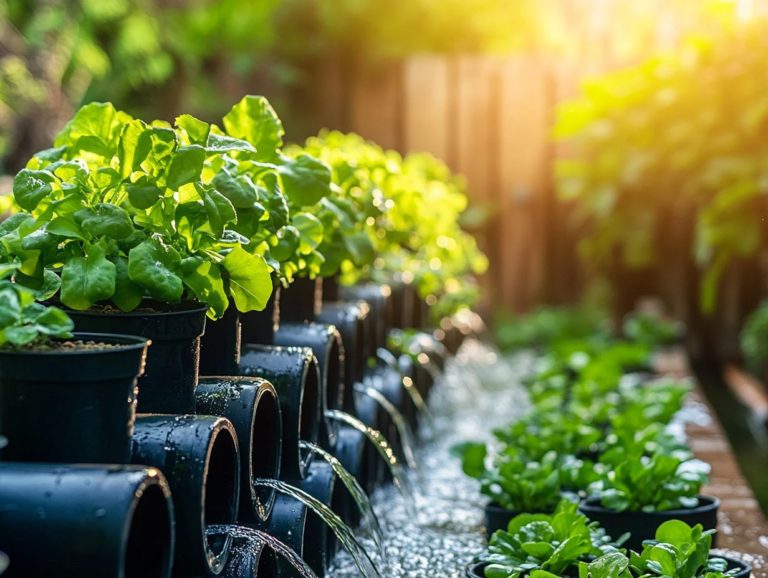How to Optimize Your DIY Hydroponic Setup
Hydroponics is revolutionizing how you grow plants, enabling you to cultivate fresh produce without the need for soil.
With the surge of DIY hydroponic systems, you have the opportunity to save costs while customizing setups to perfectly fit your space and preferences. This makes it an ideal choice for your garden project!
This guide will help you kickstart your hydroponics journey by selecting the ideal hydroponic setup, gathering essential materials, and navigating a step-by-step setup process. You’ll also find tips on pump installation and proper maintenance.
Additionally, it will provide valuable troubleshooting tips and maintenance practices to ensure that your hydroponic garden flourishes for years to come. This helps you avoid common issues like nutrient deficiencies and root rot.
Dive into the world of hydroponics and unleash your gardening potential!
Contents
- Key Takeaways:
- Benefits of DIY Hydroponic Systems
- Cost Savings and Customization
- Choosing the Right Setup
- Materials and Tools Needed
- Setting Up Your Hydroponic System
- Troubleshooting Common Issues
- Maintenance and Care
- Frequently Asked Questions
- What is a DIY hydroponic setup and why should I optimize it?
- What are the key components of a DIY hydroponic setup?
- How can I optimize my DIY hydroponic setup for maximum plant growth?
- What are the benefits of using a DIY hydroponic setup compared to traditional soil-based gardening?
- Do I need any special skills or knowledge to optimize my DIY hydroponic setup?
- Are there any common mistakes to avoid when optimizing a DIY hydroponic setup?
Key Takeaways:
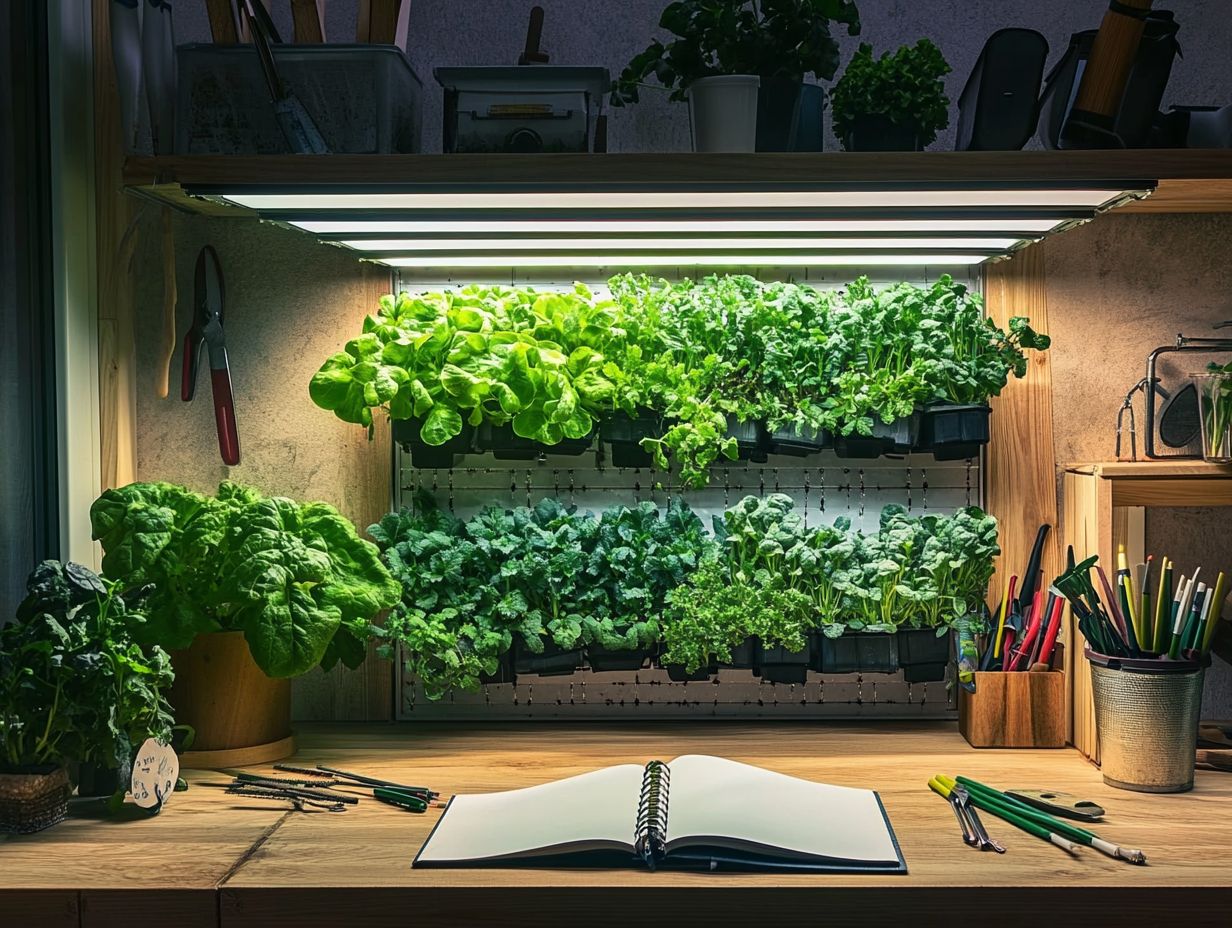
- Save money and customize your hydroponic setup by opting for a DIY system.
- Don’t wait! Think about your space, budget, and the plants you want to grow!
- Key components for a successful DIY hydroponic system include a reservoir, growing medium, and nutrient solution.
What is Hydroponics?
Hydroponics represents an innovative approach to cultivating plants without the constraints of soil, utilizing water with nutrients that delivers essential elements directly to the roots. This method not only optimizes water quality but also ensures that you provide balanced nutrients, maintain optimal pH levels (a measure of acidity or alkalinity), and enhance oxygen availability. The result? Robust plant health and impressive yields. As a sustainable gardening practice, hydroponics is rapidly gaining traction among both indoor and outdoor gardening enthusiasts.
What truly sets this method apart is its remarkable ability to significantly reduce water usage compared to traditional soil gardening, addressing critical environmental issues like water scarcity. Nutrient deficiencies, often a setback in soil-based systems, are easily managed in hydroponics; you can precisely control the nutrient levels supplied to your plants.
You ll find that many varieties of leafy greens, such as lettuce, thrive in hydroponic systems, while fruits like strawberries flourish beautifully as well. By fostering optimal root systems through controlled conditions, hydroponics maximizes plant growth and yields, making it a versatile solution for a wide array of settings.
Benefits of DIY Hydroponic Systems
Crafting your own DIY hydroponic system presents a wealth of advantages, from significant cost savings to tailored customization. It allows you to cultivate fresh produce sustainably right at home using nutrient-rich water.
By utilizing a nutrient-rich water reservoir and fine-tuning essential environmental factors such as light source and water quality, you can achieve impressive yields of crops like peppers and lettuce in a controlled environment, facilitated by tools like grow lights and air pumps. If you’re just starting out, it’s helpful to know what is the best hydroponic setup for beginners.
This hands-on approach not only refines your gardening skills but also plays a vital role in local food production, making it an enticing choice for both novices and seasoned growers interested in sustainable gardening practices.
Cost Savings and Customization
One of the standout benefits of a DIY hydroponic system is the remarkable cost savings compared to commercial setups. You can craft a portable system tailored precisely to your needs using affordable materials. By choosing DIY solutions, you have the freedom to select components like PVC fittings and plant cups that fit your budget. You can also customize the size and design of the system to make the most of any available space. This level of personalization not only elevates your growing experience but also enhances plant health and maximizes yields.
Incorporating essential tools for pump installation and ensuring water quality doesn t have to be an expensive endeavor. For example, a small, energy-efficient water pump can effectively circulate nutrients without straining your wallet. Testing kits for pH a measure of how acidic or basic a solution is and nutrient levels are also reasonably priced but absolutely crucial for maintaining optimal conditions.
Regular maintenance such as cleaning the reservoir and replacing nutrient solutions is vital and can be handled with straightforward, budget-friendly methods. By following these steps for effective hydroponic troubleshooting, you can set up an efficient hydroponic system that thrives, all without the hefty overhead costs typically seen with commercial alternatives.
Choosing the Right Setup
Selecting the right hydroponic setup is paramount for the success of your garden project. You need to consider various environmental factors, such as the light source, water reservoir size, and nutrient mix.
Each setup, be it deep water culture, nutrient film technique, or aeroponics, offers unique advantages tailored to the types of plants you wish to cultivate. By understanding the specific needs of your plants, including their optimal pH and moisture levels, you can create a more effective and productive growing environment that truly thrives. To explore innovative methods, check out the future of DIY hydroponic gardening.
Factors to Consider
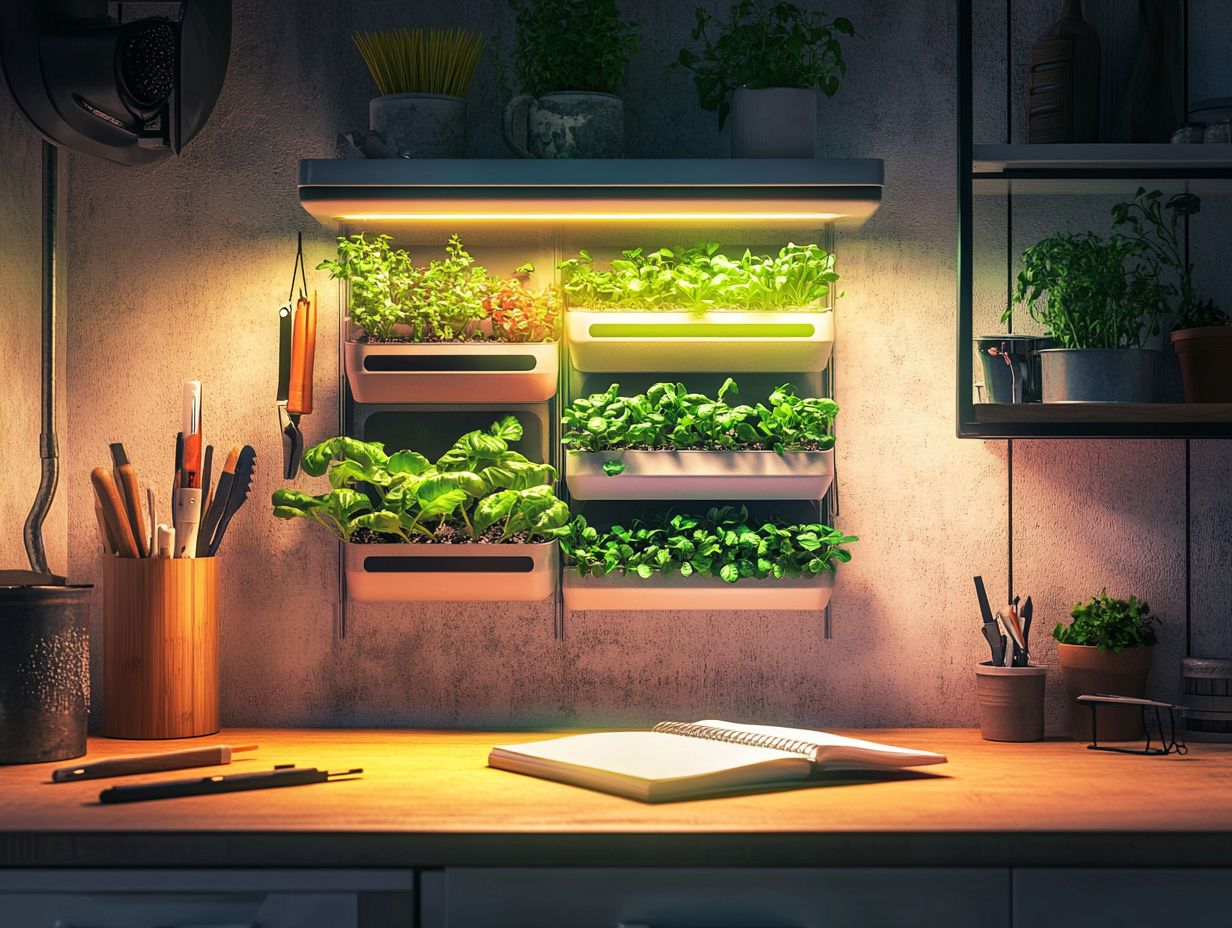
When you embark on setting up a hydroponic system, several critical factors demand your attention. It s essential to consider temperature control, humidity levels, and the meticulous monitoring of nutrient concentration to avert deficiencies.
By ensuring that your plants receive the perfect balance of nutrients while maintaining optimal conditions, you’ll foster healthy growth and robust root systems. Understanding how these elements influence plant health is key to establishing a successful and sustainable hydroponic garden. Additionally, knowing how to prevent hydroponic system failures can further enhance your gardening success.
Temperature is a pivotal factor in the growth rate of your plants, so you must maintain it within a range that aligns with the specific crops you re cultivating. Humidity levels also come into play, influencing transpiration rates and consequently affecting nutrient uptake from the solution.
Regular monitoring of the nutrient concentration in your hydroponic solution is imperative to ensure your plants receive all the essential minerals they need. This prevents deficiencies that could stunt their growth.
Employing efficient watering techniques, such as drip systems or nutrient film techniques, can further optimize your water usage and minimize waste. If you’re interested in enhancing your hydroponic skills, check out how to start DIY hydroponic gardening today. Implementing strategies to prevent algae blooms, like covering nutrient reservoirs or managing light exposure, is crucial to safeguarding the integrity of your hydroponic ecosystem.
Materials and Tools Needed
To successfully establish your own DIY hydroponic system, you ll need to gather an exciting variety of materials and tools, such as a power drill, miter saw, and essential components like PVC fittings and nutrient solutions that streamline both construction and maintenance.
The right materials do more than just support plant growth; they elevate the overall functionality of your hydroponic garden, making it easy to monitor water levels and maintain ideal growing conditions.
By investing wisely in these tools, you set the stage for a smooth-running hydroponic project that delivers high-quality produce.
Essential Components for a DIY Hydroponic System
The essential components of your DIY hydroponic system include a reliable water reservoir, a nutrient solution that provides essential food for plants, and an effective light source to create the perfect growth conditions.
Tools like air pumps, plant cups, and proper tubing are vital for delivering nutrients and oxygen to the roots. This promotes robust plant health and helps ward off issues like root rot. Grasping the role of each component is crucial in crafting a productive hydroponic garden.
Each component plays a pivotal role in maintaining the delicate balance required for your plants to thrive. The water reservoir serves as the lifeblood of your system, ensuring that moisture levels remain consistent and suitable for absorption. A well-prepared nutrient solution is vital, as it provides the balanced nutrients that directly influence growth rates and overall yield potential.
Monitoring how well the solution conducts electricity, which helps gauge nutrient concentration, is equally important. This helps you avoid deficiencies or toxicities. Adequate lighting not only stimulates photosynthesis but also mimics natural sunlight patterns, enhancing growth cycles. Together, these elements create an optimized environment for your plants to flourish.
Setting Up Your Hydroponic System
Setting up your hydroponic system requires a thoughtful, systematic approach. Begin with the selection of your setup type whether that be deep water culture or nutrient film technique and extend to the diligent maintenance needed for long-term success.
This comprehensive guide will lead you through each phase of the process. Highlights include water quality, nutrient solution preparation, and light spectrum optimization to create the ideal conditions for plant health.
By following these meticulously outlined steps, you can cultivate a flourishing hydroponic garden. This not only enhances plant health and yield but also minimizes potential challenges like nutrient monitoring and maintaining optimal moisture levels. For a comprehensive guide, check out how to set up a hydroponic NFT system.
Step-by-Step Guide
This step-by-step guide for setting up your hydroponic system will walk you through everything from selecting the right materials and tools to implementing effective watering techniques and monitoring plant health.
Start by gathering your materials, including a water reservoir and nutrient solution. Then set up your system according to your chosen method, whether it’s nutrient film technique or deep water culture. For best results, consider learning how to optimize your hydroponic layout. Each step is crucial to ensuring your plants thrive in a balanced, nutrient-rich environment.
Next, prioritize optimizing your light source, as this is essential for maximizing photosynthesis. Choose appropriate grow lights tailored to your plants’ specific needs, adjusting the height and intensity according to their growth stage.
After that, keep an eye on humidity levels. Consider adding a hygrometer to your setup to maintain optimal moisture in the air. Regularly check the pH and electrical conductivity of your nutrient solution to ensure your plants receive all the essential nutrients.
Visual aids, such as diagrams illustrating each system type, can further simplify the process. This can help your hydroponic garden flourish beautifully.
Troubleshooting Common Issues
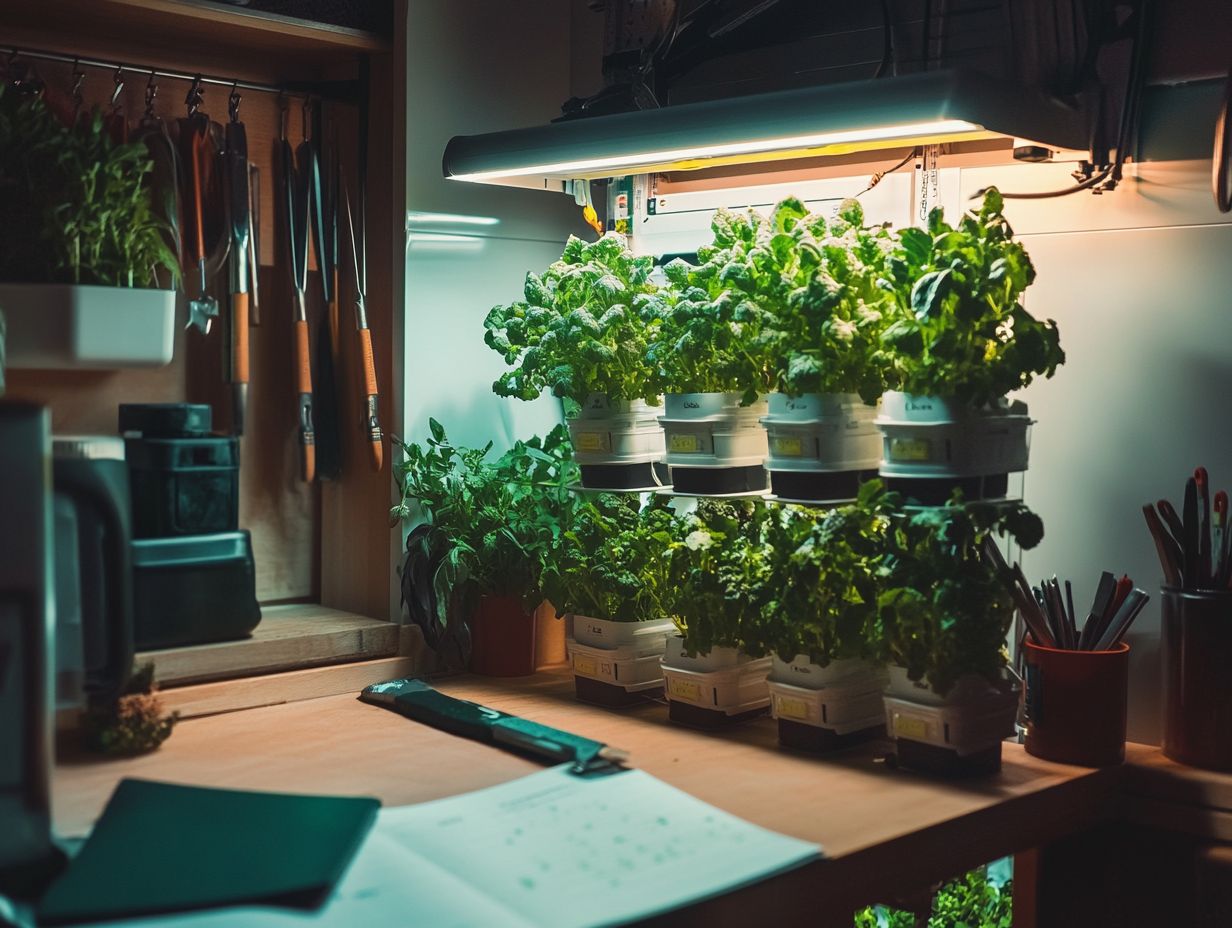
Troubleshooting common issues in hydroponic systems is crucial for maintaining plant health and optimizing yields. Problems such as nutrient deficiencies, root rot, and algae blooms can swiftly derail your garden project.
By familiarizing yourself with the signs and symptoms associated with these issues, you can take proactive steps to address them before they escalate. Adopting a systematic approach to monitoring your system will safeguard your plants and foster long-term success and productive growing conditions.
Act quickly to resolve issues! Your plants depend on you to ensure a thriving hydroponic garden.
So why wait? Start your DIY hydroponic system today and watch your plants thrive!
Identifying and Fixing Problems
Identifying and resolving issues in your hydroponic system demands a sharp eye and diligent nutrient monitoring. This helps uncover the root causes of challenges like nutrient deficiencies or lackluster plant growth.
Regularly checking environmental factors such as temperature, humidity, and water quality will help you spot discrepancies and guide your adjustments. By doing this, you can significantly enhance plant health and cultivate a more successful and sustainable gardening experience.
For instance, maintaining a balanced nutrient profile is essential. If you notice your plants developing yellowing leaves, it could signal a nitrogen deficiency, calling for an adjustment in your nutrient solution. Employing troubleshooting techniques, like observing growth patterns and using pH testing kits, can also unveil hidden problems.
An effective approach involves conducting weekly inspections of your plants and documenting any changes. This will enable you to recognize trends over time. By appreciating the significance of consistent monitoring, you can swiftly tackle any pest or disease issues that arise, ensuring the success of your hydroponic venture.
Maintenance and Care
Proper maintenance and care of your hydroponic system are essential for achieving long-term sustainability and optimal plant health. Regularly checking water levels, monitoring nutrient concentrations, and adjusting environmental factors such as temperature and humidity will create a thriving growing environment.
By committing to routine maintenance and proactively addressing potential issues, you can greatly enhance the chances of high yields and successful food production.
Keeping Your Hydroponic System Running Smoothly
Keeping your hydroponic system running like a well-oiled machine demands a commitment to regular maintenance and a proactive approach to troubleshooting challenges. This means you ll want to consistently monitor nutrient levels, water quality, and environmental factors like light spectrum and temperature.
By ensuring optimal conditions for plant growth, you can swiftly tackle any issues that arise and set the stage for long-term success in your hydroponic gardening pursuits, especially by learning how to set up a deep water culture system.
Make it a priority to check the pH and electrical conductivity of your nutrient solution regularly! Small imbalances can lead to serious plant health issues. It s just as important to periodically refresh the nutrient solution, adhering to best practices for preparation to guarantee your plants get a balanced mix of essential elements.
By implementing environmental controls like adjustable grow lights and temperature sensors, you can craft the perfect microclimate for each growth stage. This fosters robust plant development and maximizes yield. For a deeper understanding of how to optimize your setup, consider the nutrients for DIY hydroponic systems. With consistent monitoring and adaptation, you’ll cultivate a resilient system that thrives in a variety of conditions.
Frequently Asked Questions
What is a DIY hydroponic setup and why should I optimize it?
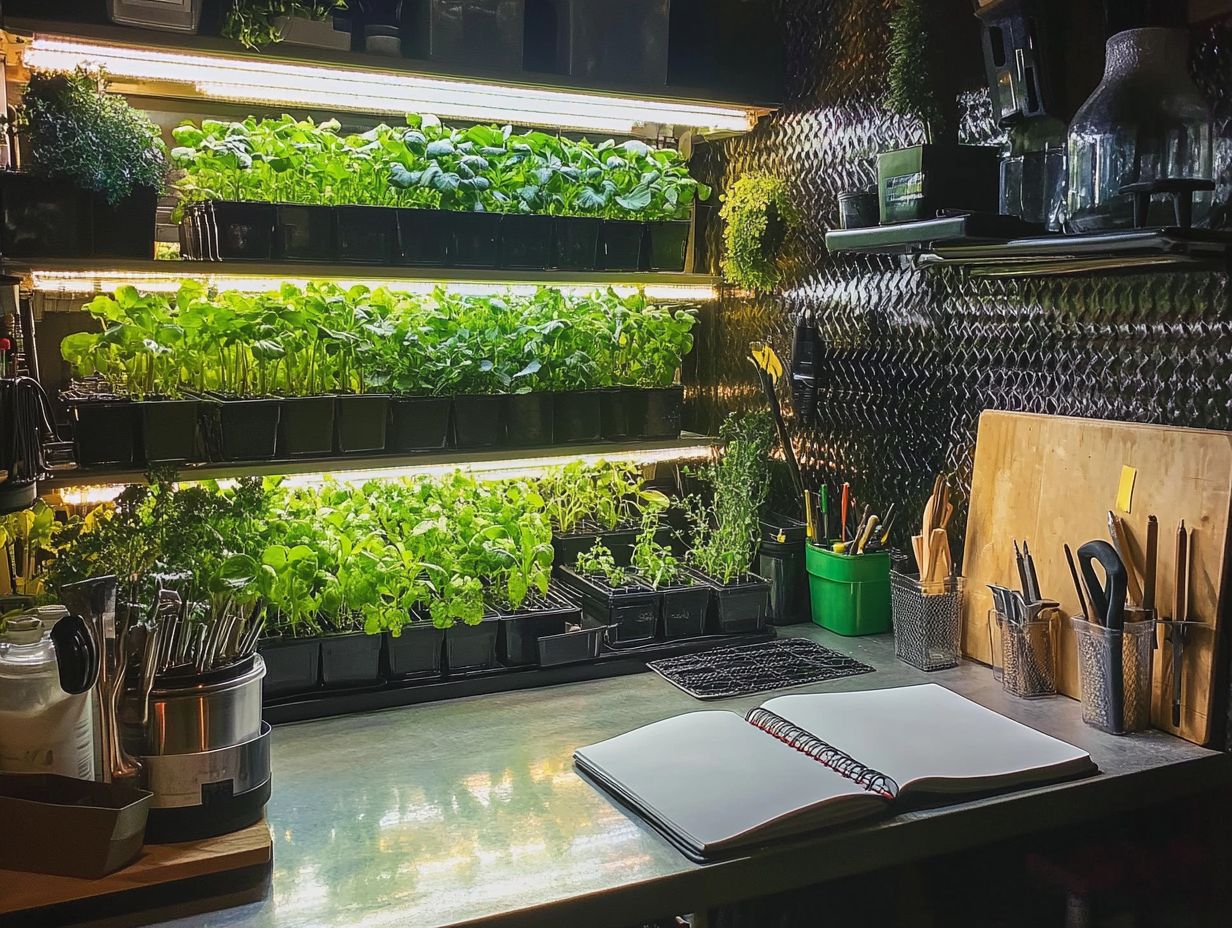
A DIY hydroponic setup is a method of growing plants without soil, using a nutrient-rich water solution instead. Optimizing your setup can improve plant growth, increase yields, and save you time and money in the long run.
What are the key components of a DIY hydroponic setup?
The key components include a reservoir, a pump to circulate the water, a growing medium or support structure for the plants, and a nutrient solution. Lighting, pH and temperature control, and proper ventilation are also important factors for optimal growth.
How can I optimize my DIY hydroponic setup for maximum plant growth?
You can optimize your setup by choosing the right lighting for your plants, ensuring proper water flow and circulation, maintaining appropriate pH and nutrient levels, and keeping the environment clean and free of pests.
What are the benefits of using a DIY hydroponic setup compared to traditional soil-based gardening?
Hydroponic setups can lead to faster growth, higher yields, and the ability to grow plants year-round regardless of climate. They also use less water and space and are less prone to pests and diseases.
Ready to enhance your gardening adventure? Dive into hydroponics today!
Do I need any special skills or knowledge to optimize my DIY hydroponic setup?
While a basic understanding of plant biology helps, you don t need to be an expert. Many beginner-friendly resources and kits are available to assist you!
Are there any common mistakes to avoid when optimizing a DIY hydroponic setup?
Avoid common mistakes! These include not mixing the right nutrients, over or under-watering, and using the wrong lights or growing mediums.
Make sure to dive deep into research! Understanding your setup can lead to amazing results.

